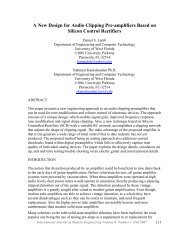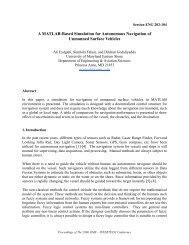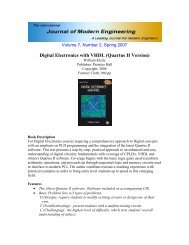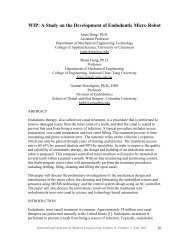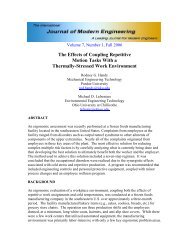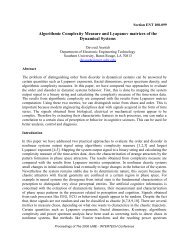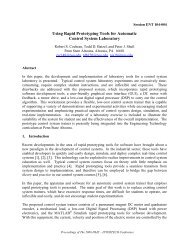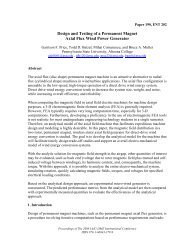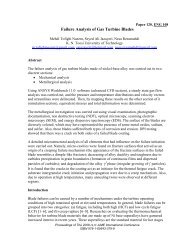Comparison Classical Method of Education and Modern Web ... - IJME
Comparison Classical Method of Education and Modern Web ... - IJME
Comparison Classical Method of Education and Modern Web ... - IJME
Create successful ePaper yourself
Turn your PDF publications into a flip-book with our unique Google optimized e-Paper software.
ABSTRACT<br />
<strong>Comparison</strong> <strong>Classical</strong> <strong>Method</strong> <strong>of</strong> <strong>Education</strong> <strong>and</strong><br />
<strong>Modern</strong> <strong>Web</strong>-Based Distance Learning System<br />
(WBDLS)<br />
Ramin Sadeghi<br />
Power <strong>and</strong> Water University <strong>of</strong> Technology<br />
Ramin_Sadeghi@pwut.ac.ir<br />
Saeid Moslehpour<br />
University <strong>of</strong> Hartford<br />
moslehpou@hartford.edu<br />
This paper will describe the classic <strong>and</strong> virtual educational methods. This contrast<br />
requires implemented samples therefore, the advantages <strong>and</strong> disadvantages <strong>of</strong> general<br />
methods are taken into consideration.<br />
The field <strong>of</strong> E-learning, <strong>and</strong> particularly <strong>of</strong> instructional design, now has a good<br />
history <strong>of</strong> creating innovative technology-based learning resources through the<br />
application <strong>of</strong> principled development methods. These methods have evolved over<br />
half a century or more looking to the roots <strong>of</strong> instructional design in the wartime work<br />
<strong>of</strong> people. In the last decade, the core practices <strong>of</strong> educational technology have been<br />
facing some severe criticism, particularly from those writing under a neoconstructivist<br />
banner. These criticisms primarily reflect epistemological <strong>and</strong><br />
pedagogical doubts. Some neo-constructivists proclaim an epistemological relativism<br />
that refuses to give a privileged status to any one way <strong>of</strong> ‘knowing’ the world. Some<br />
assert that ‘knowledge transfer is impossible’: pedagogy needs to support the<br />
individual construction <strong>of</strong> meaning.<br />
We argue that educational technology is facing a new kind <strong>of</strong> challenge, a new area <strong>of</strong><br />
opportunity. We use the label <strong>Web</strong>-Based Distance Learning System (WBDL) as<br />
shorth<strong>and</strong> for this area. WBDLS on one reading, must embrace all areas <strong>of</strong> learning –<br />
kindergarten through higher education, informal learning in the community, home or<br />
workplace, training courses in industry, adult education courses, <strong>and</strong> so on. The term<br />
may seem unhelpful, but it does emphasize the need for what might be called<br />
collaborative approaches to education which identify <strong>and</strong> systematically remove<br />
damaging discontinuities between different phases or settings for learning.<br />
INTRODUCTION<br />
In the fast changing <strong>and</strong> strongly competitive business environment we live, a<br />
confluence <strong>of</strong> factors such as the economic globalization <strong>and</strong> integration, the impact<br />
<strong>of</strong> technological developments, the growing demo for sustainable development <strong>and</strong><br />
the emerging work systems are having a strong impact on organizations, on society<br />
<strong>and</strong> on individuals.<br />
Advances in Information Technologies (IT) are now one <strong>of</strong> the major driving forces<br />
International Journal <strong>of</strong> <strong>Modern</strong> Engineering Volume 8, Number 1 Fall 2007 128
<strong>of</strong> change. IT is essential for competitiveness <strong>of</strong> other economic sectors, <strong>and</strong> the basis<br />
for trade, services delivery, production, transport, education <strong>and</strong> entertainment [1].<br />
Information technology is transforming organizations into global networked structures<br />
with processes extended through continents creating markets, systems <strong>and</strong> new<br />
perspectives.<br />
The fast evolution <strong>of</strong> IT is creating huge opportunities, <strong>and</strong> simultaneously,<br />
challenges to organizations <strong>and</strong> society. Organizations try to respond to the challenges<br />
by adapting their strategies <strong>and</strong> activities <strong>and</strong> restructuring to align themselves to the<br />
new requirements <strong>of</strong> the changing economy. Information Technologies support<br />
distributed systems, computer supported cooperative work, electronic commerce,<br />
electronic business, electronic procurement, teleportation, virtual manufacturing,<br />
concurrent engineering, <strong>and</strong> forms <strong>of</strong> distance education.<br />
<strong>Web</strong>-based distance education seems to be a contribution to democratization <strong>of</strong><br />
learning access in particular in the domain we are concerned with, the university<br />
continuing education <strong>and</strong> post-graduated education. However, the new approaches to<br />
learning are still at an immature stage. Although some <strong>of</strong> these approaches exist for<br />
several years, there is not yet a clear understating <strong>of</strong> the way they will evolve <strong>and</strong><br />
become useful <strong>and</strong> common practice.<br />
WBDL <strong>and</strong> Virtual University (VU) concepts are an integrated set <strong>of</strong> independent<br />
providers <strong>of</strong> education that are integrated to respond to an individual’s need. Figure 1<br />
shows the factors to consider. Emerging technologies, frameworks, <strong>and</strong> applications<br />
that can support the WBDL <strong>and</strong> VU models are discussed later <strong>and</strong> identify the main<br />
technologies to implement the concept.<br />
Figure 1 - Classroom – Distance learning Model<br />
HISTORY OF MODERN EDUCATIONAL SYSTEMS (DISTANCE LEARNING)<br />
The birth <strong>and</strong> development <strong>of</strong> the electronic educational systems:<br />
• Late 1960's – Digital storage <strong>of</strong> the first experimental text in computer<br />
• Early 1970's – Presentation <strong>of</strong> classical literature in the first electronic book<br />
(eBook)<br />
• Early 1980's – Establishment <strong>of</strong> the first electronic library (e-Library) at Columbia<br />
University<br />
• Late 1980's – Publication <strong>of</strong> 26 volume encyclopedia in electronic form<br />
International Journal <strong>of</strong> <strong>Modern</strong> Engineering Volume 8, Number 1 Fall 2007 129
• Early 1990's – Launching <strong>of</strong> the first electronic reading device by Sony<br />
Corporation<br />
• Early 1990's – First experimental classrooms in University <strong>of</strong> Michigan<br />
• Mid 1990's – Offering the experimental courses in universities <strong>of</strong> USA, Europe,<br />
<strong>and</strong> India<br />
• 1996 – Offering the first web-based courses<br />
• 1997 – Creation <strong>of</strong> the Virtual University<br />
• 1999 – Coexistence <strong>of</strong> the traditional <strong>and</strong> modern virtual educational systems<br />
FACTORS THAT ACCELERATE THE GROWTH OF DISTANCE LEARNING<br />
CAN BE CATEGORIZED AS FOLLOWS:<br />
• Development <strong>of</strong> communication systems' infrastructure<br />
• Reduction <strong>of</strong> the price <strong>of</strong> computers from $100 to $10 during the 1970's to late<br />
1990's<br />
• Increase <strong>of</strong> the processing speed <strong>of</strong> computers from $1 to $100 during 1960's to<br />
late 1990's<br />
• Emergence <strong>of</strong> graphical Internet <strong>and</strong> Worldwide <strong>Web</strong> (www)<br />
• Development <strong>of</strong> protocols for hypertexts <strong>and</strong> hypermedia<br />
GROWTH OF THE NUMBER OF COMPUTER USERS<br />
The number <strong>of</strong> computer users had a growth rate as shown in the following table,<br />
including an estimate for 2005: [1]<br />
• 1993: 13 million<br />
• 2001: 407 million<br />
• 2003: 650 million<br />
• 2005: 1 billion<br />
EXAMPLES OF INTEGRATED SYSTEMS FOR VIRTUAL LEARNING:<br />
The following universities are examples <strong>of</strong> the leading edge <strong>of</strong> high education in<br />
future. These institutes are pioneers <strong>of</strong> a movement <strong>of</strong> Virtual University. All these<br />
institutes have a consensus on a central issue that higher education has to undergo a<br />
special evolution before it can properly respond to the needs <strong>and</strong> progressive<br />
challenges on the 21 st century.<br />
A new system can be envisioned that comprises the following integrated educational<br />
systems:<br />
• California Virtual Campus, California State University<br />
• Cardean University<br />
• DeVry University<br />
• Michigan Virtual University<br />
• Object J (s<strong>of</strong>tware)<br />
• Online National Technological University<br />
• Online University <strong>of</strong> America<br />
• Southern Regional <strong>Education</strong> Board, Electronics Campus<br />
• University <strong>of</strong> Missouri - Kansas City<br />
• Uportal (sharable portal)<br />
International Journal <strong>of</strong> <strong>Modern</strong> Engineering Volume 8, Number 1 Fall 2007 130
• Virtual Media Lab, London University<br />
• Virtual University <strong>of</strong> Michigan <strong>and</strong> Virtual Lab<br />
• <strong>Web</strong>CT<br />
• Western Governors University<br />
• Wollongong University<br />
The methodology <strong>of</strong> Virtual University dates back 30 years when it was a static<br />
system for scientific papers <strong>and</strong> document exchange. The asymmetric form <strong>of</strong><br />
distance learning (unidirectional presentation <strong>of</strong> educational texts as developed in the<br />
Clevel<strong>and</strong> Institute <strong>of</strong> Electronics) has a 30 year record [2].<br />
Virtual Universities are <strong>of</strong>ten formed on the basis <strong>of</strong> research grants. The unique<br />
characteristics <strong>of</strong> these universities are:<br />
• Utilizing a wide spectrum <strong>of</strong> communication facilities for teaching <strong>and</strong> learning<br />
• Hypertext functionality that allows logical connection <strong>of</strong> the various parts <strong>of</strong> a text<br />
<strong>and</strong> adds to effectiveness <strong>of</strong> education.<br />
• Capability <strong>and</strong> capacity for concurrent <strong>and</strong> simultaneous access on a global scale.<br />
In Iran’s Payam Noor University <strong>and</strong> Tehran University some steps toward the<br />
statically on-line mode <strong>of</strong> presentation has been made. University <strong>of</strong> Power <strong>and</strong> Water<br />
already has some modern <strong>and</strong> superior systems <strong>and</strong> facilities for distance learning.<br />
Due to the following factors, it can be forecasted that WBDL will rise to a new higher<br />
position that attracts particular attention <strong>of</strong> the public <strong>and</strong> the authorities:<br />
• dramatic rise in expectations <strong>and</strong> dem<strong>and</strong> for learning <strong>and</strong> in particular, higher<br />
learning<br />
• limitations <strong>of</strong> facilities <strong>and</strong> resources,<br />
• the young generation that forms the dominant part <strong>of</strong> the population,<br />
A REVIEW OF THE GLOBAL EMERGENCE OF DISTANCE LEARNING<br />
SYSTEMS<br />
• Introduction <strong>of</strong> internet-based courses in existing universities as add-on or<br />
complements to the current courses<br />
• More than 400 universities have established the WBDL<br />
• Phoenix University has 92,000 students<br />
• Tamil University in India<br />
EXAMPLES OF ON-LINE EDUCATION<br />
In July 1996 the University <strong>of</strong> Missouri-Kansas City started its Virtual University<br />
project with particular attention to the academic activities via remote communications<br />
<strong>and</strong> computer science. The objective <strong>of</strong> the project was to build the necessary<br />
infrastructure <strong>and</strong> basis for education but the members <strong>of</strong> the faculty utilized it for the<br />
lectures, presentations, <strong>and</strong> exercises, <strong>and</strong> defined it as a compulsory course for all.<br />
• Internet allows for real-time participation as an active member<br />
International Journal <strong>of</strong> <strong>Modern</strong> Engineering Volume 8, Number 1 Fall 2007 131
• Internet is not only a new media that allows a large number <strong>of</strong> internal interactions<br />
but also integrates all other forms <strong>of</strong> media in a single multimedia<br />
• At the end <strong>of</strong> 1995, more than 9.5 million Americans had the Internet<br />
connectivity, showing a 100% increase over the same figure for 1994. State<br />
governments promoted the information networks, many libraries had internet<br />
access, <strong>and</strong> the cost <strong>of</strong> internet services decreased [3].<br />
EXAMPLES OF VIRTUAL UNIVERSITY<br />
Associated University, the virtual university <strong>of</strong> the Michigan State University (MSU)<br />
was created in 1998 with the following branches:<br />
• Chemical Engineering<br />
• Computer Design<br />
• Law-enforcement Police<br />
• Management<br />
• Judicial Law<br />
• Microbiology<br />
• Management <strong>of</strong> Water Resources<br />
• Physics <strong>and</strong> Astronomy<br />
Tamil Virtual University (TVU) was created in 1999 with the objective <strong>of</strong> serving the<br />
Tamil communities <strong>of</strong> the world, <strong>and</strong> <strong>of</strong>fers the following branches <strong>of</strong> service <strong>and</strong><br />
study:<br />
• Tamil Language<br />
• Consultation<br />
• Tamil Culture<br />
• Linguistics<br />
COMPARISONS OF TRADITIONAL AND COMMERCIAL METHODS<br />
In order to evaluate the performance <strong>of</strong> the Virtual University in comparison with the<br />
real universities, advantages <strong>and</strong> disadvantages should be identified <strong>and</strong> measured.<br />
Figure 2 details performance measures to evaluate. If advantages outweigh the<br />
disadvantages then the VU is a plausible solution <strong>and</strong> worth recommending.<br />
Figure 2 Element <strong>of</strong> Distance Learning Systems<br />
International Journal <strong>of</strong> <strong>Modern</strong> Engineering Volume 8, Number 1 Fall 2007 132
The educational activities <strong>of</strong> a virtual university are based on new approaches to<br />
teaching <strong>and</strong> learning. Two key elements for activating a virtual university<br />
environment are:<br />
• Ease <strong>of</strong> communication between student <strong>and</strong> teacher <strong>and</strong> ease <strong>of</strong> communication<br />
among the students<br />
• Individual <strong>and</strong> group activities <strong>and</strong> projects to meet the educational goals <strong>and</strong><br />
objectives.<br />
Other factors that influence the activation <strong>of</strong> virtual university environment include<br />
the educational approaches <strong>and</strong> viewpoints that shape the methods <strong>and</strong> means <strong>of</strong><br />
education <strong>and</strong> the classroom.<br />
Table 1: <strong>Education</strong>al System<br />
System<br />
Traditional View<br />
Characteristics (19 th <strong>and</strong> 20 th centuries)<br />
<strong>Modern</strong> View<br />
1 <strong>Education</strong>al<br />
Environment<br />
Student goes to the school<br />
or university<br />
<strong>Education</strong>al Environment<br />
goes to the student<br />
(School <strong>and</strong><br />
University)<br />
2 Viewpoint on Individual<br />
Social<br />
Teaching <strong>and</strong><br />
Learning<br />
3 Motive forces <strong>of</strong> the Rules, Regulations <strong>and</strong> St<strong>and</strong>ards<br />
system<br />
processes<br />
4 Structure <strong>and</strong> Pyramidal <strong>and</strong><br />
Distributed Networks<br />
Organization Hierarchical<br />
5 Decision-making Based on existing theories Based on the accumulated<br />
data<br />
6 Strategy Top-Down Bottom-Up<br />
7 <strong>Method</strong>s(Manageme Established<br />
Flexible<br />
nt/education)<br />
8 Source <strong>of</strong> power <strong>and</strong><br />
survival<br />
Conservatism<br />
Changeability (harmonious<br />
with the needs <strong>of</strong> society)<br />
Table 2: Central <strong>and</strong> Emphasized Issues<br />
System<br />
Traditional View<br />
Characteristics (19 th <strong>and</strong> 20 th Centuries)<br />
<strong>Modern</strong> View<br />
1 Basis <strong>and</strong><br />
Responsibility<br />
Teacher-centered, teacher<br />
is responsible<br />
Student-centered, student<br />
is responsible<br />
2 <strong>Education</strong>al<br />
Activities<br />
Emphasized<br />
Individual's activities Group activities,<br />
collaboration,<br />
participation<br />
3 Overall Emphasis on Internal factors External factors<br />
International Journal <strong>of</strong> <strong>Modern</strong> Engineering Volume 8, Number 1 Fall 2007 133
Table 3: Duties <strong>and</strong> inter-relationships <strong>of</strong> the teachers <strong>and</strong> learners<br />
System<br />
Characteristics<br />
Traditional View<br />
(19 th <strong>and</strong> 20 th Centuries)<br />
1 Learner's Duties Memorizing prepared<br />
material<br />
2 Teacher – Student<br />
Relationship<br />
Wiseman–Scholar<br />
(transfer <strong>of</strong> droplets <strong>of</strong><br />
knowledge from teacher<br />
to student at a specific<br />
time <strong>and</strong> location)<br />
3 Teacher's Role Prime <strong>and</strong> Sole Player<br />
who leads all<br />
4 Society's Role<br />
(Parents,<br />
Organizations,…)<br />
Unstructured interactions<br />
about learning<br />
<strong>Modern</strong> View<br />
Management <strong>of</strong><br />
information <strong>and</strong><br />
generation <strong>of</strong> new<br />
information <strong>and</strong> skills in<br />
search <strong>of</strong> knowledge<br />
An all encompassing<br />
group for creation <strong>of</strong> upto-date<br />
information <strong>and</strong><br />
skills to satisfy the<br />
dynamic needs <strong>of</strong> the<br />
society<br />
Presence in the margin<br />
<strong>and</strong> facilitator <strong>of</strong> the<br />
learning process<br />
Continuous Interactions<br />
towards <strong>Education</strong> for All<br />
Citizens<br />
Table 4: Courses <strong>and</strong> the contents <strong>of</strong> each course<br />
System<br />
Characteristics<br />
1 Volume <strong>of</strong> the<br />
course materials<br />
2 Learners' share in<br />
defining the contents<br />
3 Production <strong>of</strong><br />
contents<br />
Traditional View<br />
(19 th <strong>and</strong> 20 th centuries)<br />
Limited <strong>and</strong> selected<br />
Nil<br />
Mass Production (<strong>of</strong><br />
books…)<br />
4 Learning time spans Compulsory, high-school<br />
<strong>and</strong> university<br />
<strong>Modern</strong> View<br />
Unlimited <strong>and</strong> various<br />
Can be a lion's share<br />
Customization for the<br />
masses (tailored to each<br />
learner)<br />
Learning from birth to<br />
death<br />
International Journal <strong>of</strong> <strong>Modern</strong> Engineering Volume 8, Number 1 Fall 2007 134
Table 5: Tests <strong>and</strong> Examinations<br />
System<br />
Characteristics<br />
Traditional View<br />
(19 th <strong>and</strong> 20 th Centuries)<br />
1 Nature <strong>of</strong> Tests Replication <strong>of</strong> the course<br />
material as a justification<br />
for certificates<br />
2 Time <strong>of</strong> Tests Year-end or Term final<br />
exam<br />
3 Test Results <strong>and</strong> Student's grade in<br />
Grades<br />
examination<br />
<strong>Modern</strong> View<br />
Tools to measure progress<br />
towards the goals<br />
Unlimited <strong>and</strong> continuous<br />
Statistical measures <strong>of</strong><br />
performance in realizing<br />
the goals <strong>and</strong> objectives<br />
4 Tests <strong>of</strong> Diagnosis None or unused Early warning for those<br />
who may fail <strong>and</strong> flunk<br />
Table 6: Technology<br />
System<br />
Traditional View<br />
Characteristics (19 th <strong>and</strong> 20 th Centuries)<br />
<strong>Modern</strong> View<br />
1 Use <strong>of</strong> Technology Traditional automation Intelligent educational<br />
systems<br />
2 Technology's Role A Detachable element Convolved into the system<br />
<strong>and</strong> indispensable<br />
Table 7: Industrial Economy<br />
System<br />
Traditional View<br />
Characteristics (19 th <strong>and</strong> 20 th Centuries)<br />
<strong>Modern</strong> View<br />
1 Principles <strong>and</strong><br />
foundation<br />
Seller (educational<br />
system) is the determinant<br />
Buyer (learner) is the<br />
determinant<br />
2 Commodity involved Certificate <strong>of</strong> Graduation Skills, experience, <strong>and</strong><br />
knowledge that can be<br />
produced <strong>and</strong> developed<br />
3 Outputs <strong>of</strong><br />
<strong>Education</strong>al System<br />
Individual's knowledge,<br />
added value to the<br />
individual<br />
Quantifiable Knowledge<br />
<strong>and</strong> skills <strong>of</strong> value in the<br />
domain <strong>of</strong> economy<br />
International Journal <strong>of</strong> <strong>Modern</strong> Engineering Volume 8, Number 1 Fall 2007 135
System<br />
Characteristics<br />
1 Fruit <strong>of</strong> the<br />
educational system<br />
2 Creativity via<br />
accumulated<br />
knowledge<br />
Table 8: Other criteria<br />
Traditional View<br />
(19 th <strong>and</strong> 20 th Centuries)<br />
A lifelong work permit<br />
for a specific occupation<br />
Active in industrial<br />
society, with normal<br />
rewards, capable <strong>of</strong><br />
fulfilling the pre-defined<br />
undertakings<br />
<strong>Modern</strong> View<br />
Necessary knowledge <strong>and</strong><br />
skills for a specific job at<br />
graduation time with<br />
provision <strong>of</strong> multiple<br />
changing <strong>of</strong> job during the<br />
life<br />
Creative thinking <strong>and</strong><br />
management <strong>of</strong><br />
information creation, with<br />
the characteristics <strong>of</strong> the<br />
active individuals in a<br />
knowledge-based society<br />
ELIMINATION OF THE NEED FOR TEACHER AND STUDENT TO ATTEND<br />
THE CLASSROOM<br />
In Virtual University all communications are via the internet which removes the need<br />
for the teacher <strong>and</strong> students to be physically present in the classroom. Connection <strong>of</strong><br />
the student or teacher to the Internet would suffice <strong>and</strong> that is possible from any<br />
location. This reduces the need for construction <strong>and</strong> maintenance <strong>of</strong> expensive<br />
buildings <strong>and</strong> educational complexes [4].<br />
INDEPENDENCE OF CLASSROOM FROM ANY SPECIFIC TIME<br />
A major feature <strong>of</strong> the Virtual University is the ability for the student to access the<br />
course at the time <strong>of</strong> his/her choosing. This is particularly advantageous for the<br />
employed people attempting to further their education during their free time.<br />
COURSES OF HIGHER QUALITIES<br />
The Internet allows the pr<strong>of</strong>essor’s presentation to exp<strong>and</strong> beyond the lecture format<br />
allowing an opportunity to introduce many additional parameters that influence the<br />
flow <strong>of</strong> knowledge. Environmental parameters such as temperature <strong>and</strong> noise can<br />
negatively influence the quality <strong>of</strong> the classroom. Such parameters are non-existent in<br />
Virtual University where the courses are prepared by a team <strong>of</strong> experts <strong>and</strong> presented<br />
via the modern multi-media channels in a favorable mode. A shortcoming <strong>of</strong> the<br />
traditional classroom is that slow students may not catch up with the speed <strong>of</strong> the<br />
classroom without the opportunity for repetition <strong>of</strong> the program. In Virtual University<br />
the learner can repeat the same course as many times as is required for him to learn<br />
thoroughly <strong>and</strong> completely. This is a factor that improves the quality <strong>of</strong> education [5].<br />
International Journal <strong>of</strong> <strong>Modern</strong> Engineering Volume 8, Number 1 Fall 2007 136
SUPPORTING A VERY LARGE NUMBER OF STUDENTS IN A SINGLE<br />
CLASSROOM<br />
The limitations <strong>of</strong> space in the traditional classroom may prevent students from access<br />
to a course. In the virtual university classrooms can accommodate thous<strong>and</strong>s <strong>of</strong><br />
students simultaneously.<br />
ON-LINE ACCESS TO DIGITAL LIBRARIES<br />
In virtual university, all digital books <strong>and</strong> periodicals, research papers, theses <strong>and</strong><br />
papers are safely available to all students in an on-line mode that is very efficient in<br />
terms <strong>of</strong> time <strong>and</strong> convenience.<br />
Characteristics <strong>of</strong> Dynamic books <strong>and</strong> libraries<br />
• Links to additional resource material<br />
• Capabilities for searching words <strong>and</strong> expressions<br />
• Availability <strong>of</strong> related pictures, diagrams <strong>and</strong> other graphical representations<br />
• Integration <strong>of</strong> teaching, testing, evaluation, <strong>and</strong> the design <strong>of</strong> progression steps<br />
• Internet-based interactions between the student <strong>and</strong> the teacher<br />
• Integrated educational environment with voice <strong>and</strong> text <strong>and</strong> notetaking<br />
• Participation in chat-rooms, group discussions, <strong>and</strong> forums<br />
• Just-in-time availability <strong>of</strong> references <strong>and</strong> bibliographical sources<br />
• Availability <strong>of</strong> icons, displays, glossaries, <strong>and</strong> dictionaries<br />
ELECTRONIC RESEARCH IN VIRTUAL UNIVERSITIES<br />
A section <strong>of</strong> the virtual university web site should be allocated to provide an<br />
appropriate research facility <strong>and</strong> provide a listing <strong>of</strong> faculty research. Links to<br />
research questionnaires, results, statistics, research reports, <strong>and</strong> analytical reports can<br />
all be placed in this section. Visitors <strong>of</strong> the website can conveniently fill-in the<br />
questionnaires <strong>and</strong> study the latest results. An entry point for research applicants can<br />
be provided in this section so that whenever the need arises, the questionnaires can be<br />
scanned <strong>and</strong> the right researchers selected.<br />
ADVANTAGES OF ELECTRONIC EDUCATION IN ENGINEERING<br />
Engineers are under great pressures to become familiar with the latest technologies,<br />
electronic business, <strong>and</strong> commerce. MS <strong>and</strong> PhD students are <strong>of</strong>ten unable to attend<br />
scheduled classes due to work, commuter travel, <strong>and</strong> family constraints. Virtual<br />
University has greatly solved this problem by moving all their needs to their preferred<br />
study space. Major businesses that exp<strong>and</strong> their branches in various cities in different<br />
countries are also faced with the problems <strong>of</strong> training their staff employees in<br />
scattered places. Businesses have welcomed the virtual university solution.<br />
COMPONENTS OF THE WEB-BASED DISTANCE LEARNING<br />
The main topics <strong>and</strong> components <strong>of</strong> the distance learning are presented as follows:<br />
• <strong>Web</strong>-based education (CD <strong>and</strong> DVD are complementary media tools)<br />
• Virtual Events can take place in a virtual classroom<br />
International Journal <strong>of</strong> <strong>Modern</strong> Engineering Volume 8, Number 1 Fall 2007 137
• Consultation, including teacher/student consultations, inter-departmental<br />
communications, <strong>and</strong> exchange <strong>of</strong> views with others via email<br />
• Simulation <strong>and</strong> graphical representation <strong>of</strong> dynamic systems (such as Java<br />
Applets) are a significant part <strong>of</strong> the Virtual University.<br />
• Work-Groups, for collective efforts in solving problems or group discussions in<br />
forums<br />
• Evaluation, for initial selection <strong>of</strong> the students <strong>and</strong> for skipping the parts that they<br />
are already well versed in.<br />
• Electronic Store through which all needed services are reserved <strong>and</strong> all payments<br />
are made.<br />
• Administration <strong>of</strong> <strong>Education</strong> is a subsystem for student records, progress,<br />
monitors learning environment<br />
DISTANCE LEARNING CLASSES<br />
Like traditional courses the structure <strong>of</strong> electronic courses consists <strong>of</strong> various parts<br />
<strong>of</strong>ten 12 to 15 or even 16 weeks where the instructor details the delivery time for<br />
exercises, projects, <strong>and</strong> final report. Each course has its own web-page whereby the<br />
instructor informs the students <strong>of</strong> the course specifics, lecture texts, exercises, <strong>and</strong><br />
supplementary audio-visual objects. The functioning <strong>of</strong> web as a freely accessible<br />
archive is an advantage over the classic methods because students can access their<br />
desired web-page at any time. For live lectures, group discussions, or conferring with<br />
their classmates, they may have to access the system at a predetermined time. Online<br />
facilities for delivery <strong>of</strong> homework, asking questions, <strong>and</strong> expressing views on subject<br />
matter are possible through these courses. Grouping <strong>and</strong> collaboration has great<br />
pedagogical values <strong>and</strong> greatly helps the students in advancing their underst<strong>and</strong>ing <strong>of</strong><br />
the material [7].<br />
An advantage <strong>of</strong> electronic learning is the support <strong>of</strong> learners in the form <strong>of</strong> access to<br />
further information which empowers them to make decisions on the basis <strong>of</strong> the<br />
received information, the educational program, <strong>and</strong> their own skills <strong>and</strong> experiences.<br />
Another advantage is the uniformity <strong>of</strong> presentations in various repetitions <strong>of</strong> the<br />
program. This makes it possible to utilize the knowledge <strong>and</strong> experience <strong>of</strong> the best<br />
experts for any specific program. The electronic education can be repeated without<br />
any limitation [8]. The advantages <strong>of</strong> distance learning may be classified as:<br />
<strong>Modern</strong> <strong>Method</strong>s (Distance Learning)<br />
• Cost Reduction<br />
• Environmental considerations<br />
• Flexibility<br />
• Downsizing <strong>of</strong> the organization<br />
• Increased power <strong>of</strong> supervision <strong>and</strong> management<br />
• Liberation <strong>of</strong> instructor’s time for their further research <strong>and</strong> studies<br />
• Accessing unlimited data <strong>and</strong> information sources<br />
<strong>Classical</strong> <strong>Method</strong>s<br />
• Statically traditional education<br />
International Journal <strong>of</strong> <strong>Modern</strong> Engineering Volume 8, Number 1 Fall 2007 138
• Overhead <strong>and</strong> capital costs for buildings, personnel <strong>and</strong> the support services<br />
• Environmental pollution due to heating, waste disposal<br />
• Greatly oversized organizations <strong>and</strong> administrative functions<br />
• Shortcomings <strong>of</strong> supervision, comm<strong>and</strong> <strong>and</strong> control due to lack <strong>of</strong> proper means<br />
<strong>and</strong> methods<br />
• Very limited accessibility <strong>of</strong> sources <strong>of</strong> data <strong>and</strong> information<br />
It seems that distance learning can be applied to all branches <strong>of</strong> learning. First, the<br />
learner should have access to a computer whereby he can pursue learning in a variety<br />
<strong>of</strong> methods. He can have the CD or DVD for all lectures, <strong>and</strong> supplementary<br />
audio/video presentations, simulations, graphics <strong>and</strong> animations. An important point<br />
to consider is that the students learn from other students. An investigation <strong>of</strong> applying<br />
the distance learning in all branches <strong>of</strong> scientific studies seems to be a good idea.<br />
However we like to present our recommendations only cautiously. Our advice is to<br />
utilize electronic learning as one <strong>of</strong> the components <strong>of</strong> the total <strong>and</strong> complete<br />
educational system.<br />
Electronic education is a component for providing educational services at a larger<br />
scale <strong>and</strong> lower costs. We believe that the modern <strong>and</strong> classic methods need to be<br />
integrated in order to achieve the following:<br />
• Generalization <strong>of</strong> learning for all via individuals participation in specialized<br />
programs<br />
• St<strong>and</strong>ardization <strong>of</strong> academic lectures <strong>and</strong> presentations in a redesign <strong>of</strong> course<br />
materials <strong>and</strong> criteria<br />
• Consideration for the needs <strong>of</strong> industry <strong>and</strong> economy<br />
• Cost reduction in conducting <strong>and</strong> participating in courses<br />
• Virtual conferences, forums <strong>and</strong> symposiums<br />
• Participation <strong>of</strong> large groups <strong>of</strong> people in educational programs, thereby<br />
upgrading the scientific <strong>and</strong> technological awareness <strong>of</strong> the population<br />
• Better utilization <strong>of</strong> computers in education<br />
• Generalization <strong>of</strong> searching <strong>and</strong> browsing at electronic speeds<br />
ELECTRONIC EDUCATION IN STRATEGIC INDUSTRIES (OIL, GAS AND<br />
POWER)<br />
Consider the oil, gas, <strong>and</strong> petrochemical industries wherein electronic education is<br />
quite feasible. These industries rely significantly on simulations for training <strong>and</strong><br />
development <strong>of</strong> specialists for operations <strong>and</strong> control <strong>of</strong> industrial complexes [9].<br />
Safety <strong>of</strong> operation is <strong>of</strong> prime importance in the power <strong>and</strong> energy sector. Distance<br />
learning, electronic education <strong>and</strong> simulations can be utilized to upgrade the<br />
knowledge <strong>and</strong> skills <strong>of</strong> the operators <strong>of</strong> these industries. Simulations have a distinct<br />
advantage whereby no serious damages will occur.<br />
International Journal <strong>of</strong> <strong>Modern</strong> Engineering Volume 8, Number 1 Fall 2007 139
Table 10 – <strong>Web</strong>-Based Engineering Programs <strong>of</strong>fered in USA<br />
University<br />
Berkeley at<br />
California<br />
Georgia Tech,<br />
Atlanta<br />
Kansas State Univ<br />
Stanford Univ,<br />
California<br />
Wisconsin<br />
University<br />
Program<br />
Computer-based Information Systems, Long-distance<br />
communications, eCommerce, Geographical Information<br />
Systems<br />
Digital Signal Processing, Mechanical Engineering<br />
ُS<strong>of</strong>tware Engineering<br />
Artificial Intelligence, Fiber Optics, Wireless<br />
Communications<br />
Engineering Economy<br />
There are serious challenges to distance learning. Technology is changing<br />
continuously. Competition is getting tougher each day. Product life cycles are getting<br />
shorter <strong>and</strong> shorter. The time span for marketing <strong>and</strong> selling a product is also<br />
shrinking. Electronic education must adapt quickly to change [10]. Organizations who<br />
see electronic education as a measure for cost reduction <strong>and</strong> fail to motivate their<br />
human resources will not be successful.<br />
TOPICS IN EDUCATIONAL CONTENTS<br />
The important complexity that faces virtual university is its dependence on curriculum<br />
authors <strong>and</strong> developers that are members <strong>of</strong> traditional universities or employees <strong>of</strong><br />
some private companies. These authors have their own preferences <strong>and</strong> policies in<br />
preparation <strong>of</strong> curriculum. Some questions that stem from this situation are as<br />
follows:<br />
• What is the curriculum <strong>of</strong> a Virtual University<br />
• What are the differences between the curricula <strong>of</strong> the virtual <strong>and</strong> traditional<br />
universities<br />
• How are the modern views on education reflected in the Virtual University<br />
curricula, planning, <strong>and</strong> execution<br />
• What are the mechanisms that ensure maximum flexibility in educational<br />
services <strong>and</strong> how do they operate<br />
• How does the Virtual University respond to the challenges <strong>of</strong> content<br />
preparation<br />
The dependence <strong>of</strong> Virtual University on the traditional universities <strong>and</strong> private<br />
educational institutions brings about further complexities that can be summarized in<br />
the following questions:<br />
• What are the effects <strong>of</strong> revenues <strong>of</strong> the virtual university as its main guarantee<br />
<strong>of</strong> survival<br />
Although many believe in the advantages <strong>of</strong> modern approaches <strong>of</strong> distance learning<br />
others support the traditional systems <strong>of</strong> education. Reports have shown no<br />
significant difference between these two systems.<br />
International Journal <strong>of</strong> <strong>Modern</strong> Engineering Volume 8, Number 1 Fall 2007 140
• What is the position <strong>and</strong> role <strong>of</strong> the virtual university in the discussions <strong>and</strong><br />
discourses about quality <strong>of</strong> technology-based education<br />
• To what extent is the concept <strong>of</strong> distributed learning valid <strong>and</strong> reliable<br />
The Virtual University insists on the quality <strong>of</strong> education which places Virtual<br />
University in a competitive position among traditional education. Any factor that<br />
undermines the quality <strong>of</strong> education in the eyes <strong>of</strong> the students can eventually disrupt<br />
the virtual university.<br />
• What are the technical st<strong>and</strong>ards <strong>of</strong> the virtual university<br />
• What are the educational st<strong>and</strong>ards <strong>of</strong> the virtual university<br />
CONCLUSION<br />
Virtual university can be considered as a first real <strong>and</strong> serious response to the rising<br />
costs <strong>of</strong> higher education.<br />
• Can the virtual universities realize the hopes for cost reduction in higher<br />
education<br />
o Despite the very attractive financial calculations that support the<br />
virtual university on paper, many more reliable information, statistics<br />
documents <strong>and</strong> pro<strong>of</strong>s are needed to witness <strong>and</strong> support the<br />
pr<strong>of</strong>itability <strong>of</strong> distributed learning in mass scales.<br />
• How can a virtual university prepare a financial strategy to guarantee its<br />
continued operation<br />
o The importance <strong>of</strong> this question is more visible for a viable virtual<br />
university that is not born from <strong>and</strong> fed by a traditional university.<br />
• Can a combination <strong>of</strong> the academic curricula <strong>and</strong> the <strong>of</strong>ferings <strong>of</strong> the private<br />
institution be considered as a successful model for the operation <strong>of</strong> a<br />
pr<strong>of</strong>itable Virtual University<br />
Virtual universities are seeking sources <strong>and</strong> companies that can reinforce the<br />
university in various dimensions. Virtual universities seek joint ventures with<br />
publishers <strong>of</strong> the online books, companies in Information <strong>and</strong> Communication<br />
technology, <strong>and</strong> private sector companies active in education.<br />
• Can such joint ventures <strong>and</strong> associations with the private sector strengthen the<br />
educational goals <strong>and</strong> objectives <strong>of</strong> the Virtual University<br />
• Do such partnerships <strong>and</strong> ventures give birth to new clusters <strong>of</strong> companies<br />
<strong>and</strong> educational groups or are they limited <strong>and</strong> monopolize trade<br />
• Does the prospect <strong>of</strong> partnership in such new companies persuade university<br />
pr<strong>of</strong>essors to positively cooperate with the virtual university<br />
An analysis <strong>of</strong> the applications <strong>of</strong> technology in a society can answer the following<br />
questions [11]. These are probably the greatest challenges that face the virtual<br />
university.<br />
• What parts, levels, <strong>and</strong> facets <strong>of</strong> the modern technology should <strong>and</strong> could be<br />
implemented in the virtual university<br />
• What technologies can be chosen for implementation<br />
International Journal <strong>of</strong> <strong>Modern</strong> Engineering Volume 8, Number 1 Fall 2007 141
• What are the dictations <strong>of</strong> the technologies that are used by the learners<br />
A reasonable solution may be the use <strong>of</strong> a combination <strong>of</strong> the traditional <strong>and</strong> modern<br />
methods for the first few years so that everyone gets a fair chance to adapt <strong>and</strong> adjust<br />
to the new technologies <strong>and</strong> different environment that they create.<br />
• What mix <strong>of</strong> the traditional <strong>and</strong> modern methods is feasible <strong>and</strong> optimal<br />
REFERENCES<br />
[1] World-Wide <strong>Web</strong> URL http://www.geohive.com/ Last Accessed December 6,<br />
2007<br />
[2] Hisham El-Shishiny, Miriam J. Masullo, Antonio Ruiz, "A Regional Broadcast-<br />
Centric <strong>Education</strong> System," iscc, p. 139, 2nd IEEE Symposium on Computers<br />
<strong>and</strong> Communications (ISCC '97), 1997<br />
[3] World-Wide <strong>Web</strong> URL http://www-icdl.open.ac.uk/ Last Accessed December 6,<br />
2007<br />
[4] Insung Jung, Building a theoretical framework <strong>of</strong> web-based instruction in the<br />
context <strong>of</strong> distance education, British Journal <strong>of</strong> <strong>Education</strong>al Technology,<br />
Volume 32 Issue 5, November 2001, pp 525-534<br />
[5] Farnes N.C. Evaluation <strong>of</strong> an Online <strong>Education</strong> <strong>and</strong> Training Course, Ninth<br />
DELOS Workshop on Digital Libraries for Distance Learning Brno, Czech<br />
Republic, 1999<br />
[6] World-Wide <strong>Web</strong> URL http://www.webct.com/ Last Accessed December 6,<br />
2007<br />
[7] World-Wide <strong>Web</strong> URL http://www.wbtsystems.com/solutions Last Accessed<br />
December 6, 2007<br />
[8] Shaik, NMarketing, Distance Learning Programs <strong>and</strong> Courses: A Relationship<br />
Marketing Strategy, Online Journal <strong>of</strong> Distance Learning Administration,<br />
Volume 8, Number II, 2005<br />
[9] World-Wide <strong>Web</strong> URL http://www.wested.org/tie/dlrn/ Last Accessed<br />
December 6, 2007<br />
[10] World-Wide <strong>Web</strong> URL http://www.usdla.org/ Last Accessed December 6, 2007<br />
[11] World-Wide <strong>Web</strong> URL http://www.wbtic.com/ Last Accessed December 6,<br />
2007<br />
BIOGRAPHIES<br />
RAMIN SADEGHI is senior project scientist technology Group, Center <strong>of</strong> <strong>Modern</strong><br />
Training Technology in Power <strong>and</strong> Water University <strong>of</strong> Technology; he is a member<br />
<strong>of</strong> USA-IOWHE e-council. He is also director <strong>of</strong> <strong>Web</strong> Based Distance Learning<br />
Center in PWUT.<br />
SAEID MOSLEHPOUR is an Assistant Pr<strong>of</strong>essor in the Electrical <strong>and</strong> Computer<br />
Engineering Department in the College <strong>of</strong> Engineering, Technology, <strong>and</strong> Architecture<br />
at the University <strong>of</strong> Hartford. He holds PhD from Iowa State University <strong>and</strong> BS MS<br />
<strong>and</strong> EdSp degrees from Central Missouri State University. His areas <strong>of</strong> interest are<br />
logic design, CPLDs, FPGAs <strong>and</strong> distance learning.<br />
International Journal <strong>of</strong> <strong>Modern</strong> Engineering Volume 8, Number 1 Fall 2007 142



